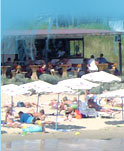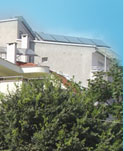
NESSEBAR
EARLY - BYZANTINE TERMS
 Terms/baths/ of Nessebar are situated in the lowest part of the western cost of the peninsula, on the northeast of church “St. John the Baptist”. Terms/baths/ of Nessebar are situated in the lowest part of the western cost of the peninsula, on the northeast of church “St. John the Baptist”.
About 2/3 of the area of terms are explored - entrance, central hall and warm premises with pools. The other part is under a modern building. Baths are supplied by underground sewerage.
They are built V-VI c. Soon then their plan is changed. Walls are covered by marble slabs. There are places where are preserved slabs about 3m high.
Four massive columns supported a cruciform dome above the central hall.
Byzantine Emperor Constantine IV Pogonat took treatment here in 680, according written data.
The baths are destroyed in the beginning of IX c. when Bulgarian khan Krum conquered the town/812/ and are used like agricultural premises.
In XIc. in the two corners of the central hall are built lime-kilns.
The reach marble decoration of terms is the main stuff. The terms are partly conserved.
FORTIFICATION WALLS
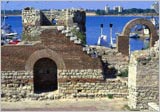 The sea was the first, but not the last bar against the attacks of the enemies. During the centuries a lot of fortified systems have been built which made of the peninsula an impregnable fortress. The sea was the first, but not the last bar against the attacks of the enemies. During the centuries a lot of fortified systems have been built which made of the peninsula an impregnable fortress.
After excavations and following conservation and restoration have started the discovered parts of the defense system became one of the imposing monuments of the past which welcomes and accompanies the guests of the ancient Nessebar today.
The first inhabitants on the peninsula – the Thracians, started the fortification of the settlement in the VIII c. BC. A fortified wall with a gate has been found from this period. It was made of hewn stone joined by mud. The wall that can be seen nowadays is 2 m high. The oval shaped bends of the walls typical for the Thracian building can be found on it. The oval shaped bends of the walls typical for the Thracian building can be found on it.
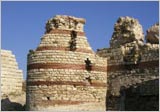 During the time of Hellenistic colonization / VI c. BC / the colonists from Megara did not start immediately the construction of a new defense system. They built a new wall later, in the end of the V c. and the beginning of the IV c. BC. The work lasted till the III c. BC. Big stone blocks were used, their face sides being specially polished, placed in line, without any solder. The inner part of the wall was felled with broken stones and soil. Some three meters of this wall are saved nowadays. The Greek wall was well studied in the west part of the town. It can be seen that in some places it overlaps the later one – the Byzantine. During the time of Hellenistic colonization / VI c. BC / the colonists from Megara did not start immediately the construction of a new defense system. They built a new wall later, in the end of the V c. and the beginning of the IV c. BC. The work lasted till the III c. BC. Big stone blocks were used, their face sides being specially polished, placed in line, without any solder. The inner part of the wall was felled with broken stones and soil. Some three meters of this wall are saved nowadays. The Greek wall was well studied in the west part of the town. It can be seen that in some places it overlaps the later one – the Byzantine.
Nessebar being conquered by the Romans, the found defense system was preserved and used during the following centuries.
After the decay of the Roman Empire the Byzantine rulers undertook an active constructional work and in the middle of the V c. AD a new fortified wall has been built in opus micstrum – alternation of stones and bricks. The best-preserved part of it can be seen today near the city gate, opposite to the strip. Here the wall was faced with big orthogonal hewn stone blocks. The gate was flanked with two square towers on both sides of which round and semicircular towers were symmetrically placed. Two gates – a drawbridge like one and a twin leafed gate closed tightly the access to the town. During the Early Byzantine period a fortified wall was built on the South – West Coast, near the port. Above it there was a row of panoramic brick arches that now give to the coast a very special picturesque view. Fragments of this wall have been found out some 80- m southwest into the sea.
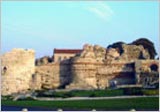 The early Byzantine system has been used during all the Middle ages. In the time of war attacks of the enemy part of it was destroyed seriously but it was quickly rebuilt. The first reconstruction was deled to the end of VI c. and the beginning of the VII c., after the attacks of the Avars. After khan Kroum conquered the city in the year 812 he pulled down the wall. Later, in the end of the century it was rebuilt of bricks. In the end of the XI c. the defense system was repaired once again. During the reign of King Ivan Alexander the walls were definitely reconstructed. The early Byzantine system has been used during all the Middle ages. In the time of war attacks of the enemy part of it was destroyed seriously but it was quickly rebuilt. The first reconstruction was deled to the end of VI c. and the beginning of the VII c., after the attacks of the Avars. After khan Kroum conquered the city in the year 812 he pulled down the wall. Later, in the end of the century it was rebuilt of bricks. In the end of the XI c. the defense system was repaired once again. During the reign of King Ivan Alexander the walls were definitely reconstructed.
After the town was subjected to Ottoman rule in 1453, the defense system lost its strategic importance and, left without any special cares, gradually declined.
POMORIE
Trakian Tomb
 Antique Trakian tomb (Heroon)– is an architectural monument from (II age. after Jesus.) and has a world significance. This is an unique place situated in gardens which are 500m South from camp “Evropa”.The monument is open for visit during the summer period. Antique Trakian tomb (Heroon)– is an architectural monument from (II age. after Jesus.) and has a world significance. This is an unique place situated in gardens which are 500m South from camp “Evropa”.The monument is open for visit during the summer period.
BEGLIK TASH
THE MEGALITHIC SANCTUARY
 The unique Thracian sanctuary “Beglic Tash” has been discovered in 2003. This is the earliest megalithic sanctuary all over the Southeast Thracia and the Black sea cost. The archaeological excavation has proofed that life and rituals have started here at the end of The Late Bronze Age (about XIII century BC). The unique Thracian sanctuary “Beglic Tash” has been discovered in 2003. This is the earliest megalithic sanctuary all over the Southeast Thracia and the Black sea cost. The archaeological excavation has proofed that life and rituals have started here at the end of The Late Bronze Age (about XIII century BC).
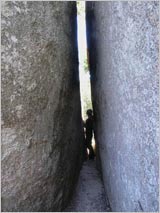 The sanctuary consists of central area and many small structures around it. The big rocks have been partially worked up and assembled. The big stones have been arranged in unique but familiar to the age way. In the flat parts of the rocks have been cut down circles, wash tubs and “Marko's steps”. The dwelling and the ritual fireplaces are parts of big ancient religious complex. The sanctuary consists of central area and many small structures around it. The big rocks have been partially worked up and assembled. The big stones have been arranged in unique but familiar to the age way. In the flat parts of the rocks have been cut down circles, wash tubs and “Marko's steps”. The dwelling and the ritual fireplaces are parts of big ancient religious complex.
|
 |
